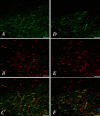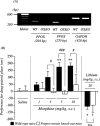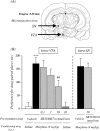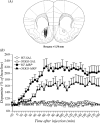Direct involvement of orexinergic systems in the activation of the mesolimbic dopamine pathway and related behaviors induced by morphine
- PMID: 16407535
- PMCID: PMC6674410
- DOI: 10.1523/JNEUROSCI.2761-05.2006
Direct involvement of orexinergic systems in the activation of the mesolimbic dopamine pathway and related behaviors induced by morphine
Abstract
In this study, we investigated the role of orexinergic systems in dopamine-related behaviors induced by the mu-opioid receptor agonist morphine in rodents. Extensive coexpression of tyrosine hydroxylase with orexin receptors was observed in the mouse ventral tegmental area (VTA). The levels of dopamine and its major metabolites in the nucleus accumbens were markedly increased by the microinjection of orexin A and orexin B into the VTA. The subcutaneous morphine-induced place preference and hyperlocomotion observed in wild-type mice were abolished in mice that lacked the prepro-orexin gene. An intra-VTA injection of a selective orexin receptor antagonist SB334867A [1-(2-methylbenzoxazol-6-yl)-3-[1.5]naphthyridin-4-yl urea] significantly suppressed the morphine-induced place preference in rats. Furthermore, the increased level of dialysate dopamine produced by morphine in the mouse brain was significantly decreased by deletion of the prepro-orexin gene. These findings provide new evidence that orexin-containing neurons in the VTA are directly implicated in the rewarding effect and hyperlocomotion induced by morphine through activation of the mesolimbic dopamine pathway in rodents.
Figures







Similar articles
-
Blockade of orexin-1 receptors in the ventral tegmental area could attenuate the lateral hypothalamic stimulation-induced potentiation of rewarding properties of morphine.Neuropeptides. 2014 Jun;48(3):179-85. doi: 10.1016/j.npep.2014.04.003. Epub 2014 Apr 21. Neuropeptides. 2014. PMID: 24793540
-
Role of orexin receptors in the ventral tegmental area on acquisition and expression of morphine-induced conditioned place preference in the rats.Neuropeptides. 2017 Dec;66:45-51. doi: 10.1016/j.npep.2017.08.003. Epub 2017 Sep 4. Neuropeptides. 2017. PMID: 28890208
-
Implication of protein kinase C in the orexin-induced elevation of extracellular dopamine levels and its rewarding effect.Eur J Neurosci. 2007 Mar;25(5):1537-45. doi: 10.1111/j.1460-9568.2007.05403.x. Eur J Neurosci. 2007. PMID: 17425580
-
Lateral hypothalamic orexin/hypocretin neurons: A role in reward-seeking and addiction.Brain Res. 2010 Feb 16;1314:74-90. doi: 10.1016/j.brainres.2009.09.106. Epub 2009 Oct 6. Brain Res. 2010. PMID: 19815001 Free PMC article. Review.
-
Role of lateral hypothalamic orexin neurons in reward processing and addiction.Neuropharmacology. 2009;56 Suppl 1(Suppl 1):112-21. doi: 10.1016/j.neuropharm.2008.06.060. Epub 2008 Jul 4. Neuropharmacology. 2009. PMID: 18655797 Free PMC article. Review.
Cited by
-
The physiological role of orexin/hypocretin neurons in the regulation of sleep/wakefulness and neuroendocrine functions.Front Endocrinol (Lausanne). 2013 Mar 6;4:18. doi: 10.3389/fendo.2013.00018. eCollection 2013. Front Endocrinol (Lausanne). 2013. PMID: 23508038 Free PMC article.
-
The hypocretin/orexin system: implications for drug reward and relapse.Mol Neurobiol. 2012 Jun;45(3):424-39. doi: 10.1007/s12035-012-8255-z. Epub 2012 Mar 20. Mol Neurobiol. 2012. PMID: 22430644 Review.
-
Orexin signaling in the paraventricular thalamic nucleus modulates mesolimbic dopamine and hedonic feeding in the rat.Neuroscience. 2012 May 17;210:243-8. doi: 10.1016/j.neuroscience.2012.02.036. Epub 2012 Mar 2. Neuroscience. 2012. PMID: 22433299 Free PMC article.
-
Dopamine and aging: intersecting facets.Neurochem Res. 2009 Apr;34(4):601-29. doi: 10.1007/s11064-008-9858-7. Epub 2008 Oct 8. Neurochem Res. 2009. PMID: 18841466 Review.
-
Orexin 1 receptor antagonists in compulsive behavior and anxiety: possible therapeutic use.Front Neurosci. 2014 Feb 13;8:26. doi: 10.3389/fnins.2014.00026. eCollection 2014. Front Neurosci. 2014. PMID: 24592206 Free PMC article. Review.
References
-
- Alhaider AA (1991) Antinociceptive effect of ketanserin in mice: involvement of supraspinal 5-HT2 receptors in nociceptive transmission. Brain Res 543: 335–340. - PubMed
-
- Aoki T, Narita M, Ohnishi O, Mizuo K, Narita M, Yajima Y, Suzuki T (2003) Disruption of the type 1 inositol 1,4,5-trisphosphate receptor gene suppresses the morphine-induced antinociception in the mouse. Neurosci Lett 350: 69–72. - PubMed
-
- Bals-Kubik R, Ableitner A, Herz A, Shippenberg TS (1993) Neuroanatomical sites mediating the motivational effects of opioids as mapped by the conditioned place preference paradigm in rats. J Pharmacol Exp Ther 264: 489–495. - PubMed
-
- Berridge KC (1996) Food reward: brain substrates of wanting and liking. Neurosci Biobehav Rev 20: 1–25. - PubMed
-
- Berridge KC, Robinson TE (1998) What is the role of dopamine in reward: hedonic impact, reward learning, or incentive salience? Brain Res Rev 28: 309–369. - PubMed
Publication types
MeSH terms
Substances
LinkOut - more resources
Full Text Sources
Other Literature Sources
Research Materials
